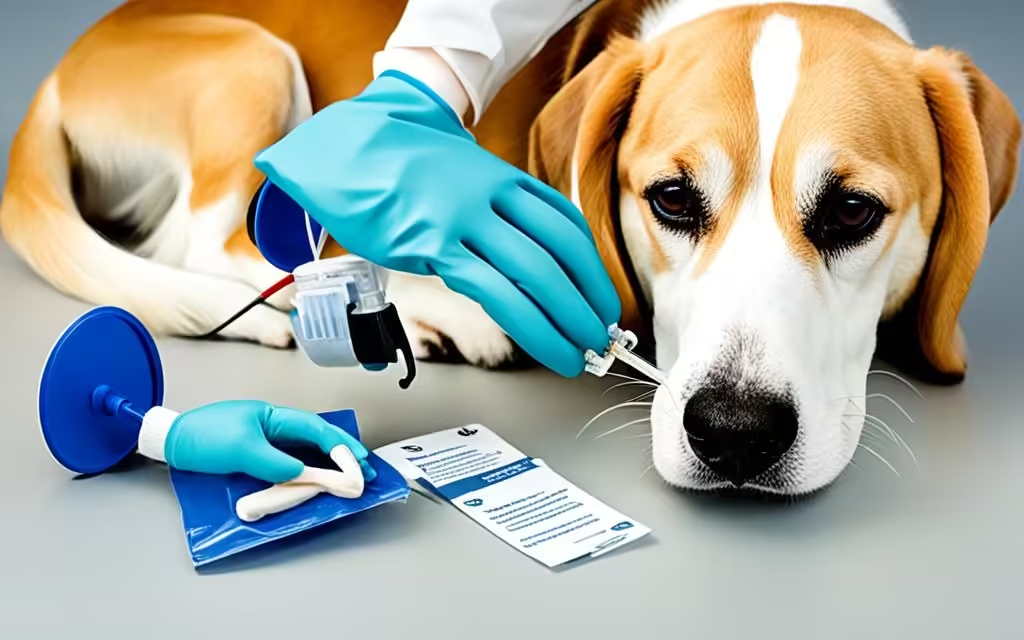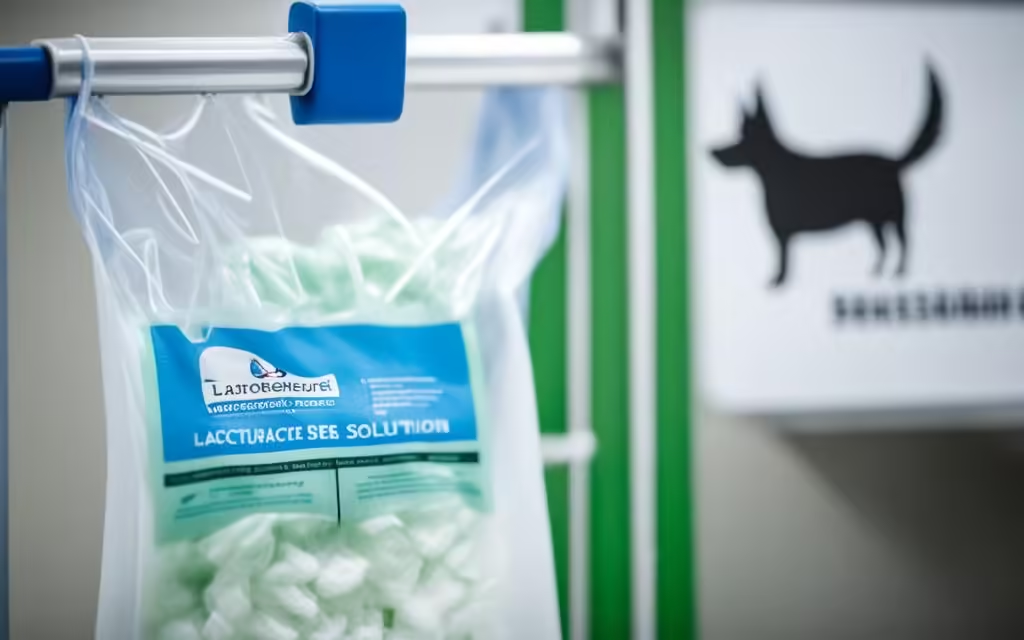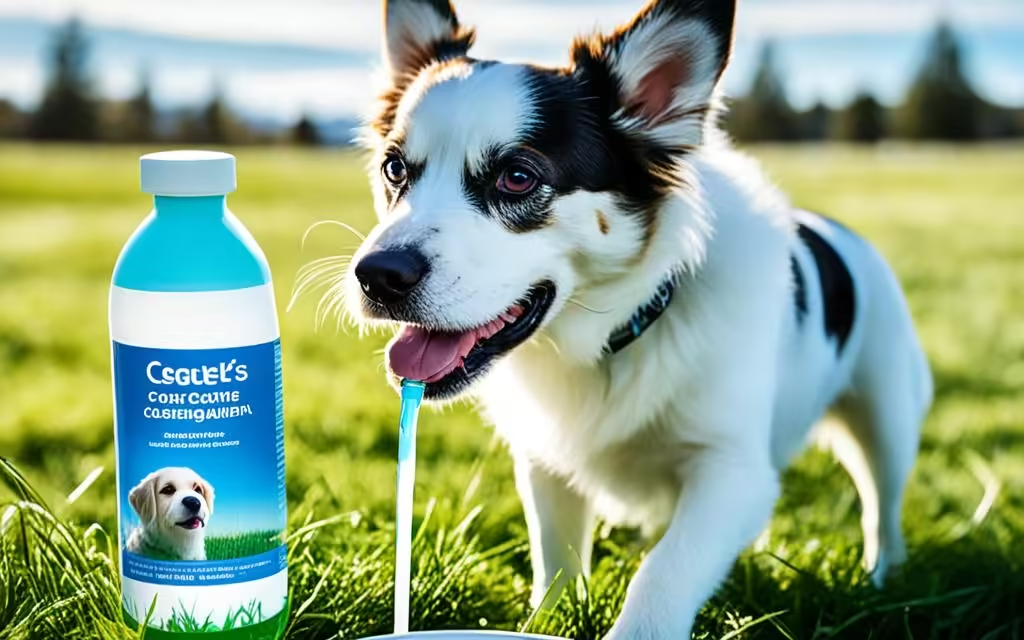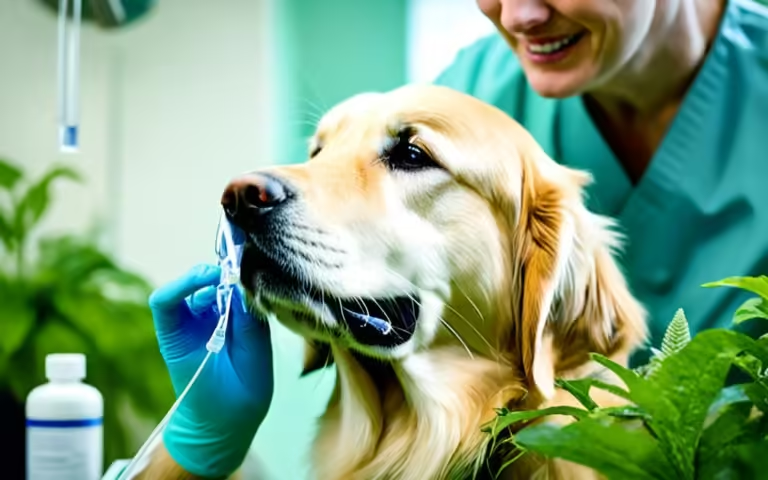Lactated Ringer’s for Dogs: Hydration Solution
Did you know Lactated Ringer’s Injection is FDA approved for dogs and cats1? It’s a big deal for pet owners, offering a trusted way to keep our dogs hydrated and healthy1. You can get it in 1L bags and use it either through an IV or under the skin, depending on what’s best for your pet1.
- Lactated Ringer’s Injection is FDA-approved for use in dogs and cats
- The solution is used for hydration and fluid replacement in animals
- Lactated Ringer’s Injection is available in 1L bags
- The drug can be administered intravenously (IV) or subcutaneously (SQ)
- Side effects are unlikely when Lactated Ringer’s is properly given
Table of Contents
What is Lactated Ringer’s Solution?
Lactated Ringer’s, also known as Ringer’s lactate or LR, is a key IV fluid used in vet medicine. It’s vital for dogs, helping with fluid replenishment and replacement2. This fluid is only by prescription and is approved for dogs, cats, and other animals. It comes in various sizes, like 1L bags2.
Drug Information
Lactated Ringer’s solution has ingredients like sodium chloride, sodium lactate, potassium chloride, and calcium chloride. These match the body’s electrolyte levels closely2. It has 6g/L of sodium chloride2 and 130 mEq/L of sodium. Plus, it has 4 mEq/L of potassium and 109 mEq/L of chloride2. The calories in this vet formula are 9 kcal/L2.
Uses and Benefits
Vets use Lactated Ringer’s to keep animals hydrated or to rehydrate them2. It’s good for treating low fluid intake and replacing lost fluids from kidney issues or sickness2. This solution helps balance fluids and electrolytes, which is key for body functions, muscle work, and nerve signals2.
Lactated Ringer’s Injection is great for adding water and electrolytes or as an alkalinizing agent3. It makes a metabolic alkalinizing effect by turning lactate ions into carbon dioxide and water3. The chance of getting too diluted is less with this solution because of its high electrolyte levels3.
“Lactated Ringer’s Injection is a trusted solution for veterinary electrolyte therapy and pet hydration, helping to maintain fluid balance and support normal physiological functions in dogs and other animals.”
Lactated Ringer’s for dog: Administering the Solution
Dosage and Administration
Lactated Ringer’s solution is given to dogs through IV or SQ, as the vet says4. The amount and how it’s given vary with each dog’s needs and condition4. It’s key to use the right technique and clean needles to keep the treatment safe and effective4.
Missed Dose Guidelines
If you miss a dose of Lactated Ringer’s, talk to your vet right away5. They’ll tell you what to do next based on your dog’s health5.
Always follow your vet’s advice when giving Lactated Ringer’s to dogs. The right amount and way of giving it is key for it to work well and keep your dog healthy4. Changing the dose or how it’s given without a vet’s okay can be harmful4.

“Proper technique and sterile needles are important when administering Lactated Ringer’s to ensure the safety and effectiveness of the treatment.”
| Product | Price (12 units of 1000 ml) |
|---|---|
| Lactated Ringer’s Injection 1000 ml | $120.446 |
| Vetivex Veterinary pHyLyte Injection pH 7.4, 1000 ml | $120.446 |
| Sodium Chloride (Saline) 0.9%, 500 ml | $153.966 |
By following your vet’s advice and giving Lactated Ringer’s right, you can help your dog get the fluids they need for health4. Keeping in touch with your vet is important during treatment546.
Potential Side Effects and Precautions
Lactated Ringer’s solution is usually safe for dogs, but some side effects and precautions should be kept in mind7. Most adverse reactions come from how it’s given or from the dog’s health, not the solution itself7.
Side effects of lactated Ringer’s in dogs might include a high body temperature, infection at the injection spot, blood clots, or swelling of a vein7. Be careful with pets that have kidney, heart, or urinary tract issues. They might get overhydrated more easily7.
Lactated Ringer’s solution should not be given to animals allergic to its ingredients7. Always get vet advice to use it safely, especially if your pet has health issues or needs it for a long time7.
It’s important to watch the patient’s fluid balance, electrolyte levels, and acid-base balance closely when using lactated Ringer’s for a long time7. If you see any bad reactions, stop using the solution right away7.
There are also precautions to keep in mind when using lactated Ringer’s in dogs8. Don’t give it to newborn dogs (≤28 days) with ceftriaxone because it can cause a dangerous reaction8. Some dogs may have allergic reactions, including anaphylaxis, to lactated Ringer’s Injection, USP8.
Be extra careful with lactated Ringer’s in dogs with severe kidney problems. It can lead to high potassium levels and fluid overload8. Older dogs are more likely to get electrolyte imbalances from this solution8.
In summary, lactated Ringer’s is usually safe for dogs, but getting vet advice is key for proper use and watching for side effects7. Always consider the dog’s health history and keep a close eye on them while they’re on this hydration solution789.
Lactated Ringer’s for Dogs: Storage and Drug Interactions
Storing and handling Lactated Ringer’s Injection right is key for keeping it safe and effective for dogs. It comes in sizes like 250mL, 500mL, 1000mL, and 5000mL10. Keep it between 68°F and 77°F to avoid freezing10. Using clean techniques and the right storage keeps the fluid safe and ready for dogs.
Storage Guidelines
The pH of Veterinary Lactated Ringer’s Injection, USP is between 6.0 and 7.5, and its osmolarity is 273 mOsmol/L10. It comes in plastic bags and should be stored at room temperature (25°C/77°F)10. Keeping it away from too much heat is important. This way, the Lactated Ringer’s solution stays safe and effective for dogs.
Drug Interactions and Compatibility
Lactated Ringer’s Injection might not mix well with some additives or medicines11. Always check with a vet or pharmacist before adding anything to it11. Make sure to mix it well and use a clean technique to avoid problems.
Using Lactated Ringer’s Injection can cause issues like fever, infection, blood clots, swelling, or too much fluid in the body10. Keep an eye on the dog’s fluid balance, electrolytes, and acid levels if using it for a long time10.

Knowing how Lactated Ringer’s Injection works with other drugs or additives is crucial for safe use in dogs11. Storing, handling, and talking to vets can keep Lactated Ringer’s Injection safe and effective for dogs101112.
Signs of Overdose and Toxicity
An overdose of lactated Ringer’s injection in dogs can cause serious symptoms. These include weakness, fast breathing, constipation, a higher heart rate, coughing, and wheezing13. If you think your dog has overdosed, get vet help right away. They will check your pet before giving more Lactated Ringer’s.
Signs of toxicity in dogs can include stomach issues like vomiting and diarrhea14. In bad cases, it might lead to lactic acidosis, but this is rare15. It’s key to watch your pet’s vital signs closely for the first 8-10 hours after an overdose13.
Quick action is important if your dog accidentally takes lactated Ringer’s. This might mean making them vomit, giving fluids through a vein, and using activated charcoal13. Vets might also give medicines like apomorphine to help get rid of toxins and stop more from being absorbed13. Giving more Lactated Ringer’s can help keep your dog hydrated and get rid of the extra fluid13.
With the right treatment, most dogs get better and their liver and kidneys work normally again13. But, always watch your dog closely and get vet help fast if you think they’ve had too much lactated Ringer’s131415.
Comparing Lactated Ringer’s with Other Hydration Solutions
Lactated Ringer’s solution is a top choice for hydrating dogs. It’s better than other fluids like saline or dextrose because it’s more like the body’s own fluids16.
About 60% of a mammal’s body is water, split into 67% inside cells and 33% outside16. Fluid balance is kept by sodium, chloride ions, and serum osmolality in healthy animals16. Lactated Ringer’s is great for rehydrating and keeping fluids balanced because it’s isotonic and has the right osmolality17.
Other fluids like dextrose 2.5% in 0.45% saline are good for keeping fluids up when you add potassium chloride or for low-sodium patients17. Hypotonic solutions like 5% dextrose are for patients with too much sodium or as a sugar source with electrolytes17. But, hypertonic solutions like dextrose 5% in 0.9% saline are risky and can cause dehydration in dehydrated animals17.
The right hydration solution depends on the situation and what you want to achieve. Lactated Ringer’s is often the best choice for rehydrating and keeping fluids balanced in dogs1617.
Fluid overload can be bad news, especially if a dog’s lungs are already struggling18. It’s key to watch closely and adjust doses when giving fluids to dogs161718.
Lactated Ringer’s for dog: Ordering and Administration at Home
How to Order and Administer at Home
Pet owners must get Lactated Ringer’s from a vet because it’s only by prescription19. It’s used for dogs, cats, and horses19. Your vet will teach you how to use it safely at home.
You’ll need things like sterile bags, tubing, and needles19. It’s important to keep everything clean to avoid problems like swelling or infection20. Your vet will guide you on how to set up and give the solution to your pet.
- Get a prescription for Lactated Ringer’s from your vet.
- Buy the needed items, like bags, tubing, and needles.
- Learn the right way to keep things clean and give the solution from your vet.
- Give the Lactated Ringer’s to your pet as your vet tells you.
- Watch your pet closely before and after giving the solution.
- Call your vet right away if you have any worries or questions.
Giving Lactated Ringer’s at home is key for your pet’s health and hydration19. By following your vet’s advice and keeping things clean, you can help your pet stay healthy at home.
Lactated Ringer’s is only for vets to use20. Make sure kids can’t get it, and only use it as your vet says to keep your pet safe and healthy212019.
Understanding the Mechanism of Action
Lactated Ringer’s is a key intravenous fluid solution for dogs. It helps keep the right balance of fluids and electrolytes in dogs. It’s important for vets to know how it works to use it safely and effectively.
This solution has a mix of electrolytes like sodium, potassium, calcium, and lactate ions22. These ions are crucial for many body functions, like muscle work, nerve signals, and keeping fluids in balance23.
When given to dogs, lactated Ringer’s adds back these important electrolytes and fluids. This helps keep the body hydrated and balanced23. The lactate in it turns into bicarbonate in the liver, helping fix acid imbalances from dehydration or shock.
Lactated Ringer’s is better than some other fluids at expanding blood volume and keeping fluids in balance22. It does this by pulling water into the blood, which increases blood volume and helps tissues get enough blood flow.
Also, its electrolyte mix is similar to what’s in the body. This makes it a better match for dogs compared to other fluids22. This helps the body accept the solution easily, lowering the chance of bad reactions.
In short, lactated Ringer’s helps dogs by fixing fluid balance, adding needed electrolytes, and supporting important body functions. Vets can use this knowledge to make better choices for their patients232224.
Conclusion
Lactated Ringer’s is a key fluid therapy for dogs. It helps keep them hydrated and replaces lost electrolytes25. This solution is similar to normal plasma, making it great for treating dehydration, shock, and some diseases26. It’s important to get vet advice on how and when to use it to keep dogs safe and healthy27.
When using Lactated Ringer’s on dogs, it’s crucial to tailor the treatment to each dog’s needs26. Vets should know the best ways to give it to dogs and how to check on their fluids and electrolytes26. They should also be ready for any side effects, know how to store it, and understand how it might interact with other medicines25.
Knowing about Lactated Ringer’s for dogs helps vets make smart choices. This knowledge lets them give the best care to their furry patients27.
FAQ
What is Lactated Ringer’s Solution?
What are the key ingredients in Lactated Ringer’s?
How is Lactated Ringer’s used for dogs?
How is Lactated Ringer’s administered to dogs?
What are the potential side effects of Lactated Ringer’s in dogs?
How should Lactated Ringer’s be stored?
Can Lactated Ringer’s be mixed with other medications or additives?
What are the signs of Lactated Ringer’s overdose in dogs?
How does Lactated Ringer’s compare to other hydration solutions for dogs?
How can pet owners obtain and administer Lactated Ringer’s at home?
Source Links
- Lactated Ringer’s
- Veterinary Lactated Ringer’s Injection, USP for Animal Use – Drugs.com
- No title found
- Veterinary Lactated Ringer’s and 5% Dextrose Injection, USP
- How to Give Subcutaneous Fluids to Dogs and Cats
- Electrolytes for Dogs & Cats
- Lactated Ringer
- label
- Resuscitative Fluid Therapy for Circulatory Shock
- Vetivex Veterinary Lactated Ringer’s Injection, USP for Animal Use – Drugs.com
- Lactated Ringer’s (Lactated Ringer’s Injection): Side Effects, Uses, Dosage, Interactions, Warnings
- Diuretics for Use in Animals – Diuretics for Use in Animals – Merck Veterinary Manual
- Animal Hospital of North Asheville
- Toxicology Brief: Metformin overdose in dogs and cats
- vetm0407_
- Fluid therapy: Choosing the best solution for each patient
- Fluid Therapy for Critically Ill Dogs and Cats – WSAVA2005
- Massive Ringer’s lactate infusion: comparison with dextrose 5% and whole blood.
- Vetivex Lactated Ringer’s Injection 250 ml | 1800PetMeds
- Lactated Ringers Injection – Revival Animal Health
- Vetivex Vet Lactated Ringers Solution
- No title found
- The Fluid Resuscitation Plan in Animals – The Fluid Resuscitation Plan in Animals – Merck Veterinary Manual
- Influence of acetate- vs. lactate-containing fluid bolus therapy on acid-base status, electrolytes, and plasma lactate in dogs
- 2013 AAHA/AAFP Fluid Therapy Guidelines for Dogs and Cats
- jaaha5868 149..159







